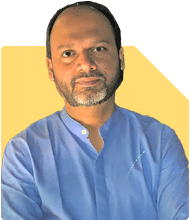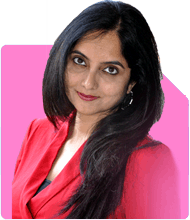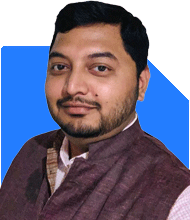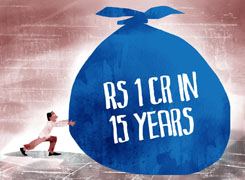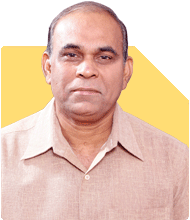Ramalingam Kalirajan |10874 Answers |Ask -Follow
Mutual Funds, Financial Planning Expert - Answered on Jul 18, 2025
He has an MBA in finance from the University of Madras and is a certified financial planner.
He is the director and chief financial planner at Holistic Investment, a Chennai-based firm that offers financial planning and wealth management advice.... more

Sir I am 44 yers old and my monthly net salary is 1.85lak. Please help me with a plan to save enough corpus for my daughter education and my retirement ( expected pension 1.5lak , retirement 55 yrs ) Daughter age 14yrs Expected UG education cost : 25 Lak The following are my investemmts and liabilities. Mutual fund 70lak Equity : 5 lak Bank balance 3 lak Gold : 15 Lak Properties : 5cr ( dont want to sell them ) Loans : 55k home loan ( 16 yrs left ) Car loan : 16k ( last 7 emi left )
? Review Your Cash Flow & Goal Timelines
– Monthly net take?home is Rs.?1.85?lakh.
– You have recurring expenses and two loans.
– Car loan EMI Rs.?16k for 7 more months.
– Home loan EMI Rs.?55k for 16 years.
– Daughter is 14; college fee of Rs.?25?lakh needed in 4 years.
– Retirement comes in 11 years.
– Goals have shorter timelines than retirement, so prioritise wisely.
? Emergency Fund & Liquidity Check
– You hold Rs.?3?lakh in bank and Rs.?15?lakh emergency fund.
– Total liquid backup is Rs.?18?lakh.
– This covers 5–6 months of take?home salary.
– It is healthy given your goal timelines.
– Continue holding this separately in liquid mutual fund.
– Do not deploy this towards loans or goals.
? Home Loan Review & Priority
– Outstanding home loan is 16?year balance with Rs.?55k EMI.
– Interest cost over term is significant.
– But prepay only if surplus is available.
– As your education goal is near, avoid major prepayment now.
– After daughter's goal is funded, review prepayment again.
– Until then, continue EMI and maintain liquidity.
? Car Loan – Crystal?Clear Path Ahead
– Car loan EMI is Rs.?16k for next 7 months.
– Once cleared, cash flow improves.
– Immediately redirect freed money post?clearance.
– This will boost your savings rate.
? Education Goal – Rs. 25?Lakh Corpus
– Your daughter needs Rs.?25?lakh in 4 years.
– That is shorter timeframe.
– Equity SIP may face volatility.
– But absence of cash risk suggests partial equity investment.
– Use a balanced approach:
Invest 50% via balanced mutual fund or debt?oriented hybrid.
Invest remaining 50% via equity?oriented hybrid for growth.
– Avoid index funds—they only replicate market and have no downside defence.
– Actively managed funds can moderate falls and improve returns.
– Maintain discipline with monthly SIPs via regular plans through MFD and CFP.
– Consider a top?up via lumpsum if surplus arises after car loan clearance.
– As time shortens (2 years left), gradually shift to debt?oriented funds via STP.
? Retirement Planning – 11 Years to 55
– You aim to retire at 55 with Rs.?1.5?lakh monthly pension.
– To support this, build Rs.?10–12?crore corpus or start a systematic withdrawal plan.
– Your current mutual fund corpus is Rs.?70?lakh in equity.
– You also have Rs.?15?lakh in gold which supports wealth smoothing.
– Avoid real estate, as it locks up capital and lacks liquidity.
– Your focus should shift to financial assets for retirement.
– Start equity SIP for retirement with at least Rs.?50,000 per month.
– Use a mix of mid?cap, large?cap, flexi?cap, and small?cap funds.
– Actively managed equity funds are preferred over index funds.
– Avoid direct mutual fund plans unless you can monitor and rebalance diligently.
– Regular plans via CFP offer ongoing discipline and review.
– A structured asset allocation:
70% equity hybrid and multi?cap for growth.
30% debt funds and PPF for stability.
– This will balance volatility and keep fund available by retirement.
– Plan for SIP step?up each year by 10–15% to build corpus faster.
? Debt & Safer Assets – Stability Backbone
– You hold gold worth Rs.?15?lakh, good as hedge.
– Maintain status; don’t buy more gold now.
– For safety, continue PPF or debt instruments post?retirement.
– Use liquid funds to avoid market risk.
– Corpus allocation needs 40% debt by retirement age.
– Create a shift plan from equity to debt starting at age 50.
? Mutual Fund Taxation Awareness
– Equity mutual funds held over 1 year: LTCG above Rs.?1.25?lakh taxed at 12.5%.
– Short?term equity gains taxed at 20%.
– Debt fund gains taxed per income slab.
– For retirement withdrawals, SWP blended across years eases tax.
– For education corpus, time redemption to minimise tax.
– CFP advice helps optimise taxable gains across slots.
? LIC and ULIP – Time to Exit
– You have LIC policies and a ULIP?like investment.
– LIC plans are low?return, high?charges.
– ULIPs often come with high allocation costs.
– They also merge insurance and investment poorly.
– Better to exit after lock?in period.
– Surrender proceeds and shift funds to actively managed equity funds via MFD and CFP.
– Purchase a standalone term insurance policy for yourself.
– Avoid insurance?investment mixes and annuities.
? Insurance – Cover Aligned to Goal
– You need a pure term cover of Rs.?2?–?3?crore depending on expenses.
– This ensures family stays secure if anything arises.
– Also ensure your daughter's education is covered under term plan protected sum.
– Maintain separate health insurance with sufficient cover.
? Property Holdings – Wealth, Not Cash
– You hold Rs.?5?crore in property.
– You wish to keep these.
– That is fine; but property is not liquid or yield?oriented.
– Avoid using these assets as emergency backup.
– Focus on cash and financial asset creation instead.
? Yearly Reviews & Discipline
– Have yearly reviews with a Certified Financial Planner.
– Assess fund performance and re?balance if needed.
– Increase SIPs with salary raises.
– After car EMI ends, redirect funds into SIPs.
– Also, annually assess loan structure and prepayment possibilities.
– Keep your SIP investments simple and goal?oriented.
? Avoid These Common Pitfalls
– Don’t chase index funds—they lack active management.
– Don’t pick direct funds—lack guidance may hurt.
– Stay away from chit funds or unsolicited stock tips.
– Don’t mix insurance and investment.
– Avoid an aggressive loan prepayment that depletes reserves.
– Don’t ignore tax planning while redeeming funds.
? Involve Your Family
– Keep your spouse informed about the plan.
– Share progress and discuss goal readiness.
– Involve them in reviewing finance yearly.
– This builds joint commitment and transparency.
? Final Insights
– You are earning well and have good base assets.
– This gives you strong foundation to build goals.
– Daughter’s education need is near; build dedicated SIP accordingly.
– Retirement planning can run in parallel with higher SIP for long term.
– Exit LIC and ULIP plans and transition funds into managed equity.
– Use actives managed mutual funds in regular plans via CFP.
– Step?up SIP each year and rebalance portfolio.
– Avoid selling property; instead build financial asset base.
– Within 11 years, you can accumulate a large corpus securely.
– Family-oriented financial discipline brings peace and security.
– With regular support, you’ll achieve both goals comfortably.
Best Regards,
K. Ramalingam, MBA, CFP,
Chief Financial Planner,
www.holisticinvestment.in
https://www.youtube.com/@HolisticInvestment.
You may like to see similar questions and answers below
Ramalingam Kalirajan |10874 Answers |Ask -Follow
Mutual Funds, Financial Planning Expert - Answered on Jul 18, 2024
Ramalingam Kalirajan |10874 Answers |Ask -Follow
Mutual Funds, Financial Planning Expert - Answered on Sep 24, 2024
Naveenn Kummar |233 Answers |Ask -Follow
Financial Planner, MF, Insurance Expert - Answered on Sep 17, 2025
Ramalingam Kalirajan |10874 Answers |Ask -Follow
Mutual Funds, Financial Planning Expert - Answered on Oct 14, 2025
Mayank Chandel |2569 Answers |Ask -Follow
IIT-JEE, NEET-UG, SAT, CLAT, CA, CS Exam Expert - Answered on Dec 08, 2025
Mayank Chandel |2569 Answers |Ask -Follow
IIT-JEE, NEET-UG, SAT, CLAT, CA, CS Exam Expert - Answered on Dec 08, 2025

Mayank Chandel |2569 Answers |Ask -Follow
IIT-JEE, NEET-UG, SAT, CLAT, CA, CS Exam Expert - Answered on Dec 08, 2025
Mayank Chandel |2569 Answers |Ask -Follow
IIT-JEE, NEET-UG, SAT, CLAT, CA, CS Exam Expert - Answered on Dec 08, 2025
Mayank Chandel |2569 Answers |Ask -Follow
IIT-JEE, NEET-UG, SAT, CLAT, CA, CS Exam Expert - Answered on Dec 08, 2025
Anu Krishna |1746 Answers |Ask -Follow
Relationships Expert, Mind Coach - Answered on Dec 08, 2025
Ramalingam Kalirajan |10874 Answers |Ask -Follow
Mutual Funds, Financial Planning Expert - Answered on Dec 08, 2025
Samraat Jadhav |2499 Answers |Ask -Follow
Stock Market Expert - Answered on Dec 08, 2025
Ramalingam Kalirajan |10874 Answers |Ask -Follow
Mutual Funds, Financial Planning Expert - Answered on Dec 08, 2025
Radheshyam Zanwar |6737 Answers |Ask -Follow
MHT-CET, IIT-JEE, NEET-UG Expert - Answered on Dec 08, 2025





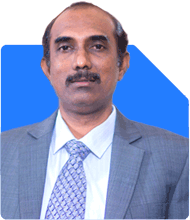



.jpg)


